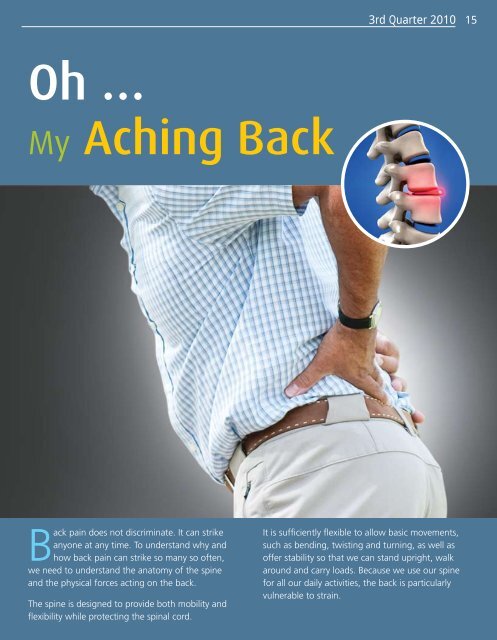Oh... My Aching Back - Saudi Aramco
Oh... My Aching Back - Saudi Aramco
Oh... My Aching Back - Saudi Aramco
You also want an ePaper? Increase the reach of your titles
YUMPU automatically turns print PDFs into web optimized ePapers that Google loves.
4th 3rd Quarter 2010 2009 15<strong>Oh</strong> …<strong>My</strong> <strong>Aching</strong> <strong>Back</strong><strong>Back</strong> pain does not discriminate. It can strikeanyone at any time. To understand why andhow back pain can strike so many so often,we need to understand the anatomy of the spineand the physical forces acting on the back.The spine is designed to provide both mobility andflexibility while protecting the spinal cord.It is sufficiently flexible to allow basic movements,such as bending, twisting and turning, as well asoffer stability so that we can stand upright, walkaround and carry loads. Because we use our spinefor all our daily activities, the back is particularlyvulnerable to strain.
16Panorama<strong>Back</strong> injury risk factorsAny of the structures that composethe spine is a potential source of painand injury, which is why back painis considered a symptom of a widerange of possible causes. Althoughmany back injuries tend to be theresult of cumulative damage sufferedover a long period of time (e.g., agingand sedentary lifestyles), you cansignificantly reduce your chances ofdeveloping a back injury by addressingthe following common risk factors.PosturePoor posture puts unwanted pressureon your discs and vertebrae, whichcan strain the back and fatiguemuscles. Bending the spine out of itsnatural position for long periods oftime often leads to muscle fatigueand back pain. In addition, whenexperiencing back pain, you are morelikely to use your back incorrectly andinjure it.Poor physical conditionPoor physical condition increases thelikelihood of back injury. The musclesof the abdomen provide neededsupport for the back. If these musclesare weak due to lack of exercise,the back may not get the supportit needs. Excess weight aroundthe middle tends to pull the pelvisforward, creating stress and pressureon the lower back.Improper lifting and bodymechanicsLifting improperly, awkward bodypositions and poor habits can causeboth chronic and acute injuries to thespine.A significant amount of extra pressurecan be placed on your lower back inparticular if you don’t practice goodlifting techniques and body mechanics.Even picking up a newspaper couldcause a strain if carried out incorrectly.Tension and emotional stressStress, if not managed properly, cancause muscle tension. Tense musclesare more susceptible to strains, sprainsand spasms. Make sure you take timeto relax properly and stretch musclesout, especially if you feel tense.Poor nutritionMaintaining a healthy weight andeating well-balanced meals help keepbones, muscles and ligaments strongand will help shed excess weight. Itis an important part of maintaininga strong healthy back. A diet witha sufficient daily intake of calcium,phosphorus and vitamin D promotesbone strength. Calcium-rich foodscome in the form of cereals, fruitjuices, leafy green vegetables andcanned fish, and magnesium throughwhole grains, leafy green vegetables,beans and nuts. Three servingseach day of low-fat or fat-free dairyproducts, such as milk and yogurt, willboost calcium and vitamin D levels,and help your bones.Note: Smokers are more likelyto develop lower back pain thannonsmokers. The nicotine in cigarettesmoke thickens the walls of bloodvessels and restricts the flow of bloodthrough the large and small bloodvessels of the lower back.Do children and adolescentssuffer from back pain?<strong>Back</strong> pain can strike anyone, anytimeincluding children and adolescents.Recent studies conducted in theUnited Kingdom have shown that halfof all children of secondary school agehave experienced back pain and arefour times more likely to suffer fromback pain as adults. Heavy schoolbagsand ill-fitting classroom furniturehave been cited as the main causes.Although these factors certainly docontribute, sedentary lifestyles andpoor posture also play a significantrole in childhood back pain.The car culture and playing computergames have reduced physical activityamong children and encouragedpoor posture. Inactivity coupled withthe growing trend for junk food hasled to weight gain among childrenand weakened muscles, all of whichcontribute to back injuries.Adolescent backs also have to dealwith the effects of puberty. Growthspurts cause structural changes within
















